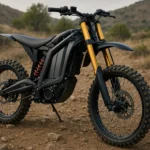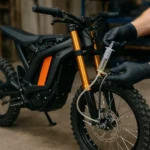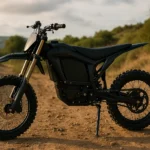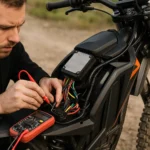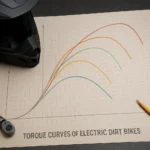Welcome Rider! Let’s Talk About Laws, Dirt, and California Roads 🌴
If you’ve ever asked yourself, “Are electric dirt bikes street legal in California?”, you’re not alone — we’ve all been there, staring at our bike and dreaming of taking it beyond the trails.
California is not exactly the Wild West when it comes to motor laws anymore. In fact, it’s one of the strictest states when it comes to electric vehicles — and yes, that includes your dirt-shredding beast.
If you’re not sure what’s legal and what’s not, check out our full breakdown: Are Electric Dirt Bikes Street Legal? Everything You Need to Know Before Hitting the Road.
In this guide, we’ll walk you through exactly what makes an electric dirt bike street legal in California, what the DMV wants from you, how to avoid fines, and how to actually enjoy the road without looking over your shoulder.
✅ We’ll answer:
- What does “street legal” even mean in Cali?
- What equipment do I need?
- Can I convert my off-road e-dirt bike legally?
- And… how much is this going to cost me?
Pull up your gloves, buckle your helmet (DOT-approved, of course 😎), and let’s break down the street legality of electric dirt bikes in California — the right way.
Spoiler: It’s not impossible, but it’s not plug-and-play either.
Are Electric Dirt Bikes Street Legal in California? (Here’s the Legal Status)
So, let’s get one thing clear: most electric dirt bikes are NOT street legal in California by default. Yeah, kind of a buzzkill… but there’s hope. 😅
In the Golden State, these bikes are usually considered Off-Highway Vehicles (OHVs) under the California Vehicle Code. That means they’re meant for dirt trails, private lands, and the occasional backyard adventure — not your neighborhood streets or downtown L.A.
But here’s the twist:
You can make your e-dirt bike street legal in California — if (and that’s a big IF) you play by the rules.

What the Law Actually Says
According to California DMV regulations, for your electric dirt bike to hit public roads, it needs to:
- Be properly registered
- Meet motorcycle-level safety standards
- Fall into a legal vehicle category (like motor-driven cycle or motorized bicycle)
If it doesn’t meet those standards, guess what? It’s stuck off-road. No shortcuts.
💡 Quick tip: If your bike came from the factory without a VIN, mirrors, or turn signals… it’s probably not road-ready. Yet.
What Makes a Dirt Bike “Street Legal”?
Here’s a checklist of must-haves:
- Headlights + Taillights
- Brake light
- Turn signals (front and rear)
- Rearview mirrors (both sides)
- Horn
- DOT-approved tires
- Muffler (yes, even for electric — because of noise laws)
- Speedometer
- And of course, a license plate mount
That’s right — your sleek, silent, battery-powered ride needs all this to share the road with traffic in Cali.
✅ Pro tip: Just because your e-bike is quiet doesn’t mean it’s legal. California also enforces noise limits — especially in cities like San Francisco and L.A.
Electric vs Gas Dirt Bikes — Legally Speaking
Now you might be thinking:
“Wait, aren’t electric bikes easier to legalize since they don’t pollute?”
Short answer: not really.
Both gas and electric dirt bikes face nearly the same legal hurdles. While electric dirt bikes don’t have tailpipe emissions (big win!), they still need:
- All the same safety equipment
- DMV registration
- A proper classification under state law
So no, you don’t get a free pass just because your bike is eco-friendly. 🌱
Requirements for Street Legal Electric Dirt Bikes in California
Alright, let’s say you’re serious about hitting the streets with your electric dirt bike — no more hiding on backroads or hoping no one sees you. 😅
Here’s exactly what you need to transform that trail beast into a DMV-approved road machine.
Essential Equipment Checklist
For your electric dirt bike to be street legal in California, it has to meet the same equipment standards as a regular motorcycle. No shortcuts, no “almost good enough.” You’ll need:
- 🔦 Headlight with high/low beam
- 🔴 Taillight + brake light
- 🔄 Turn signals, front and back
- 🪞 Dual mirrors — one on each side
- 📢 Horn loud enough to wake a distracted driver
- 🛞 DOT-approved tires
- 💨 Muffler or noise-compliant system
- 📈 Speedometer
- 📛 License plate bracket (must be visible and secure)
Miss even one of these, and the DMV will send you back to the garage.
💡 Hot tip: Use LED lights where possible. They’re brighter, more durable, and consume less battery — win-win-win.
VIN and Title: Your Bike’s Birth Certificate
Your bike must have a Vehicle Identification Number (VIN) to get registered.
- If your e-dirt bike came from a major brand, it likely has one.
- If it’s custom-built or imported, you’ll need to apply for a VIN through the California DMV.
Once you’ve got that sorted, it’s time to apply for a title. This proves ownership and is mandatory for registration.
🛑 No VIN? No title? No street for you.
Emissions and Noise Compliance
Here’s the good news:
Electric dirt bikes don’t produce tailpipe emissions. That gives you a huge advantage over gas-powered bikes in California, where emission rules are super strict.
BUT…
Don’t crank your motor controller too high or install an aftermarket system that makes your bike scream — noise laws still apply.
The state wants your ride to be as quiet as a ninja in slippers. 😎
DMV Registration Guidelines for Electric Dirt Bikes
So your bike is equipped, legal-ish, and ready to find out are electric dirt bikes street legal in California for real? Not so fast — we’ve got one last boss fight: the DMV. 😬
Registering your electric dirt bike isn’t rocket science, but it is paperwork city. Here’s how to survive it and come out with a shiny license plate in hand.
While the California DMV doesn’t separate electric dirt bikes from gas-powered ones in its registration rules, all off-road motorcycles — regardless of power source — must meet the same OHV registration requirements before being made street legal.
Required Paperwork and Documents
To register your electric dirt bike with the California DMV, you’ll need:
- 🧾 Proof of ownership (manufacturer’s certificate of origin or bill of sale)
- 🔢 A valid Vehicle Identification Number (VIN)
- 📝 Completed Application for Title or Registration (Form REG 343)
- 🔍 A vehicle verification inspection form
- 💨 A smog certification (usually not needed for electric bikes — bonus!)
- 🪪 Proof of liability insurance
Don’t show up missing any of these — the DMV clerk has zero patience for scavenger hunts. 😅
✅ Pro tip: Make copies of everything. DMV lines are long; second visits are longer.
Registration Categories: What’s Your Bike?
The DMV doesn’t call everything a “dirt bike.” Depending on your bike’s specs, it may fall into different categories:
1. Motorized Pedalcycle
- Less than 3 brake horsepower
- Max speed under 30 mph
- Minimal requirements (but still needs registration)
2. Motor-Driven Cycle
- More powerful electric dirt bikes
- Requires M1 or M2 license
- Full street equipment needed
3. Off-Highway Motor Vehicle (OHMV)
- Default category for dirt bikes
- Not street legal
- Can be converted with proper upgrades
🔍 Not sure which category fits your bike? Ask the DMV or a licensed inspection center before registering — don’t guess.
Converting an OHMV to Street Legal
If your bike is already registered as off-road only, don’t panic — conversion is possible.
You’ll need to:
- Add all required street equipment
- Get DOT tires and license plate bracket
- Pass a DMV safety inspection
- Submit a reclassification request
Once approved, your e-dirt bike will be upgraded to a dual-purpose beast — ready for both backwoods and boulevards. 🌲🚦
💡 Bonus: Some riders use professional conversion services to handle all this. More on that later.
License and Insurance Obligations
Okay, so your bike is tricked out, fully equipped, and the DMV gave it the thumbs-up. You’re almost there! But now comes the part where you — the rider — need to be legal too.
Do You Need a Motorcycle License?
Yup. If you’re planning to ride your electric dirt bike on public roads in California, you’ll need one of the following:
- Class M1 License – lets you ride any type of motorcycle or motor-driven cycle
- Class M2 License – limited to mopeds and motorized bicycles (usually not enough for powerful e-dirt bikes)
To get either, you must:
- Pass a written test
- Pass a skills test (unless you complete a certified motorcycle training course)
- Be at least 16 years old
✅ Pro tip: If your bike is classified as a low-speed electric scooter (rare), a regular driver’s license might be enough — but check with the DMV to be sure!
Insurance: Don’t Hit the Road Without It
In California, liability insurance is mandatory for all street-legal vehicles — and that includes electric dirt bikes. No exceptions.
Minimum coverage limits:
- 💵 $15,000 for injury or death (per person)
- 💵 $30,000 per accident (total bodily injury)
- 💵 $5,000 for property damage
These are just the legal bare minimums. You can (and probably should) get more coverage, especially if you ride in busy areas.
Keep Proof With You at All Times
If you’re pulled over and can’t show proof of insurance, be ready for:
- 📉 Fines
- 🛑 Possible license suspension
- 🚔 Vehicle impoundment
Not a fun day.
🔥 Pro community tip: Some insurance providers now offer plans specifically for electric motorcycles. You might get better rates and better protection for your battery-powered baby.
Local Ordinances and Riding Restrictions in California
So you’ve got the gear, passed inspection, got the license, and your electric dirt bike is officially street legal in California. You’re ready to ride, right?
Well… not quite. 😬
Even if your bike is DMV-approved, local laws can still block your ride in certain areas. Welcome to the fine print.
City and County Rules: The Hidden Layer
Each city or county in California can enforce its own rules for where and how electric dirt bikes can be used.
Here’s what that means in practice:
- 🛑 Some cities completely ban dirt bikes on public roads, even if they’re street legal.
- 🚧 Others only allow them on roads with speed limits under 35 mph.
- 📢 Certain areas have strict noise ordinances — even for electric bikes.
- 🅿️ Some municipalities require special parking permits or restrict where bikes can be parked or stored.
⚠️ Real talk: You might be street legal in Fresno but totally banned in a Los Angeles neighborhood.
Where Can You Ride?
Let’s break it down clearly:
✅ Allowed Locations:
- Private property (with owner’s permission)
- Designated off-road trails
- Some low-speed residential roads (check local signage)
- Specialized recreation zones and public parks (when permitted)
❌ Banned or Restricted Locations:
- Highways and freeways (no chance, sorry!)
- Most major city streets
- Nature reserves and protected lands
- Parks with noise or motorized vehicle restrictions
💡 Community tip: Always check your local city or county website before hitting the streets. Fines for violating local ordinances can be steep — and in some cities, your bike could be impounded on the spot.
A Rider’s Map Hack
Not sure where to ride legally?
- Try apps like Rever or OnX Offroad, which include legal riding zones
- Call your local police department (non-emergency line) — they’re surprisingly helpful
- Join local e-bike Facebook groups — they often share up-to-date info on where people are riding (without getting busted)
Important Safety Regulations for Electric Dirt Bikes in California
Alright rider, time for some tough love: just because your bike is electric doesn’t mean you’re immune to danger — or to the law. 🛑
California takes rider safety seriously, and that means more than just putting on a cool helmet and hoping for the best.
Here’s what the state expects from you.
Helmet Laws: No Ifs, No Buts
Wearing a helmet on an electric dirt bike is not optional — it’s the law.
Whether you’re 16 or 60, California requires all riders to wear a helmet that meets DOT (Department of Transportation) standards when riding on public roads.
✅ Pro tip: Get a full-face helmet for extra protection and wind-blocking comfort. Style points included.
Recommended Protective Gear
While the helmet is mandatory, here’s what the pros and seasoned riders strongly recommend:
- Gloves (because palm burns suck 😖)
- Long sleeves or a lightweight armored jacket
- Durable pants — no shorts, bro
- Boots or sturdy shoes that cover the ankles
💡 Riding gear isn’t just about looking cool — it’s what separates a scrape from a hospital bill.
Passengers: One Seat, One Rider
California law states: no passengers allowed unless your electric dirt bike is specifically built for two.
That means:
- You need a second seat and passenger foot pegs
- Your registration must reflect passenger capacity
🚫 No more “hop on, bro!” moments unless the bike is designed for it.
Age Limits and Licensing
To ride a street-legal electric dirt bike in California:
- You must be at least 16 years old
- And have a valid M1 or M2 license
Underage riders? They’re restricted to:
- Private property
- Approved off-road parks and trails
🧠 Community reminder: Riding without a license or supervision could get your bike impounded and land your parents a hefty fine. Yikes.
Are Electric Dirt Bikes Street Legal in California Without Modifications?
Many riders wonder if they can skip the upgrade process and still ride legally. This section breaks down whether it’s possible to hit the streets straight from the box — and what minimum requirements must be met to avoid legal trouble.
Modifying Electric Dirt Bikes for Street Use in California
So, you’ve got an off-road electric dirt bike and a dream of riding it down Sunset Boulevard. Good news? It can be done. Bad news? It’s not as easy as slapping on a mirror and calling it a day. 😅
Let’s break down what it really takes to make your off-road beast street-legal in California.
Aftermarket Parts You’ll Need
To truly answer are electric dirt bikes street legal in California, your ride must be upgraded with specific street-legal components before it passes inspection. No exceptions. Here’s the must-have mod list:
- ✅ Headlight with high/low beam
- ✅ Taillight and brake light
- ✅ Front and rear turn signals
- ✅ Rearview mirrors on both sides
- ✅ Loud horn (DMV will test it!)
- ✅ DOT-certified tires (off-road knobs won’t cut it)
- ✅ Speedometer
- ✅ License plate bracket (clearly visible)
- ✅ Approved muffler or noise-compliant system
All parts must meet California DMV standards, so don’t grab random eBay specials unless they’re certified. 😉
🧠 Community tip: LED kits are a game changer — they save battery and look slick.
Performance & Controller Mods
Let’s talk power.
Electric dirt bikes are often modded for higher torque, faster acceleration, and top speed. But here’s the catch:
- The bike must remain within the DMV power limits
- Excessive top speed could bump it into a motorcycle class, triggering stricter requirements
- Some controllers allow for speed limit modes, which can help meet compliance temporarily
💡 Tuning your controller? Make sure it has an ECO mode or a limit switch you can activate during inspection.
Can You Do It Yourself?
Technically? Yes.
Realistically? It depends on your experience.
DIY conversions are possible if you:
- Know your way around wiring and electronics
- Have access to proper tools
- Understand California’s street-legal checklist
Miss one requirement and the DMV will send you back faster than your bike in Turbo Mode. 🏎️💨
Professional Conversion Services
Don’t want the headache?
There are shops in California that specialize in dirt-to-street conversions. These pros:
- Install certified equipment
- Handle DMV inspections
- Submit the paperwork for you
- Make sure your bike passes the noise/emissions rules
💰 It’s not cheap (expect $500–$1,500+), but it’s faster, cleaner, and 100% legal.
Penalties for Non-Compliance in California
Thinking of skipping the paperwork and riding your electric dirt bike on public streets anyway?
Yeah… don’t. 😬
California doesn’t mess around when it comes to vehicle compliance. If your electric dirt bike isn’t fully street legal, here’s what you’re risking:
Fines and Legal Trouble
Caught riding without proper registration or required equipment? You’re looking at:
- 💰 Fines between $100 and $250 for the first offense
- 🔁 Higher fines for repeat violations
- 🏛️ Possible mandatory court appearances
- 🚔 Bike impoundment (yes, they can and will take it)
⚠️ Real rider story: We’ve seen folks lose $1,000+ in tickets and fees — all because they didn’t want to add a mirror and a plate.
Points on Your License
Illegal riding can also hit your driving record:
- You may receive moving violations
- These violations add points to your license
- Accumulate enough, and you risk suspension or revocation
🧠 Heads up: Those points also make your insurance go ⬆️ real fast.
Insurance Denials
If your bike isn’t legally registered, guess what?
- Your insurance may be invalid
- Claims from accidents or injuries may be denied
- You could be stuck paying out-of-pocket for thousands
Even worse? You might not be able to buy legal insurance at all until your bike meets DMV standards.
Bottom Line
Trying to sneak by the rules isn’t just risky — it’s expensive, stressful, and downright dumb when you think about it.
For a few hundred bucks in upgrades and paperwork, you can stop asking are electric dirt bikes street legal in California and just ride legally, confidently, and without having to dodge every cop car you see. 😅
Comparison With Other States + Future Trends
So… how does California compare to other states when it comes to legalizing electric dirt bikes?
Well, let’s just say: Cali’s one of the toughest. But it’s not the only game in town.
State-by-State Differences
Every U.S. state has its own set of rules when it comes to street-legal electric dirt bikes. Some are surprisingly chill — others, not so much.
✅ States with More Lenient Laws:
- Texas – Often allows electric dirt bikes on public roads if power and speed stay below certain limits.
- Florida – Easier registration process, especially for low-speed electric vehicles.
- Arizona – Permits street use if basic safety features are added. Less red tape.
❌ Stricter States:
- New York – Complicated regulations, especially within NYC.
- Massachusetts – Strong restrictions on modifications and licensing.
- California – High standards, but still possible if you follow all the steps.
⚠️ Important: Just because your e-dirt bike is street legal in one state doesn’t mean it’s legal in another. To get the full picture of legality across the U.S., don’t miss our comprehensive article on electric dirt bike street legality by state.
Interstate Riding Considerations
Traveling with your electric dirt bike across state lines?
Make sure you have:
- All registration documents
- Valid insurance papers
- A visible and secure license plate
And always confirm:
- Whether helmet laws differ
- If vehicle classifications change
- What speed or power limits apply in the state you’re visiting
🧭 Pro tip: If you’re planning road trips with your bike, map out legal riding zones using apps or local forums beforehand.
The Future of Street-Legal E-Dirt Bikes in California
Here’s the exciting part: Things are changing fast.
California lawmakers are looking into new vehicle classifications for electric dirt bikes that fall somewhere between scooters and motorcycles — making it easier to ride legally with fewer requirements.
Possibilities include:
- A new low-speed electric off-road category
- Simpler licensing for limited-power bikes
- Relaxed rules for eco-friendly electric models
Why the shift?
Because electric dirt bikes are exploding in popularity — especially among young riders, commuters, and city dwellers who want a fun, clean alternative to cars.
More Enforcement + More Education
With the boom in popularity comes more attention from law enforcement.
Expect:
- 🔍 More inspections
- 🚨 Crackdowns on illegal street use
- 📚 Public awareness campaigns about how to ride legally
But the trend is clear: Electric is the future.
And the more riders follow the rules, the more likely it is that California will expand access, loosen restrictions, and support the movement.
Final Thoughts: Ride Smart, Ride Legal
Look — we get it. Electric dirt bikes are fun. They’re fast, clean, and make you feel like a superhero on two wheels. ⚡🦸♂️
But if you want to take that fun beyond the dirt and onto California streets, you need to play by the rules.
A lot of riders still ask: “Are electric dirt bikes street legal in California?”
This entire guide was built to answer that — and the truth is: yes, they can be, if you follow all the right steps.
From gear and registration to insurance and inspections, this guide gave you everything you need to go from off-road outlaw to street-legal rider.
So do it right.
Get your paperwork in order.
Install the right equipment.
And ride with confidence — no cops, no stress, just the open road and your electric freedom machine. 🏁
Want more tips, updates, or e-dirt bike community hacks? Follow us and ride with the crew. We’re all about keeping it legal, safe, and fast. 🚀
🧭 Still curious about how electric dirt bike laws vary across the U.S. or wondering what’s changing in 2025? Check out our full guide on Are Electric Dirt Bikes Street Legal? — it’s packed with state-by-state comparisons, legal tips, and everything you need to ride smart no matter where you are.

Tyler Brooks is the storyteller behind most of the content at Electric Dirt Zone. With over 10 years of experience in digital media and a lifelong love for off-road riding, he blends technical insight from the team with engaging, down-to-earth writing. When he’s not turning dusty trail rides into blog posts, you’ll probably find him snapping pics before things get too wild.


